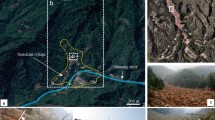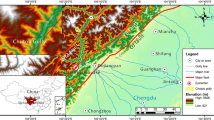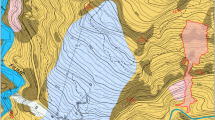Abstract
Channel bed erosion accompanying debris flows can significantly magnify the flowing mass and increase the associated risk. However, the mechanics of this geological phenomenon is extremely complex, which greatly increases the difficulty of predicting the dynamical behavior and bulking process of large-scale debris flows. This study employs the depth-averaged two-phase r.avaflow model to numerically analyze the flow propagation and sediment erosion processes. Two modified empirical erosion laws are further embedded in the r.avaflow framework to comparatively compute the channel erosion of a typical catastrophic debris flow occurring in Wenchuan earthquake-affected mountainous areas. The results show that both of the two erosion models can effectively reproduce the movement and channel erosion of the debris flows under investigation. In addition, the most serious sediment erosion has been found to occur along the two sides of the channels. Additionally, r.avaflow model with its simple CE-controlled erosion law relating the erosion coefficient to the slope topography is further applied to predict the dynamical behavior and bulking process of the Hongchun gully debris flow under 50- and 100-year recurrence intervals. The discharge and hazard intensity are shown to greatly increase under the effect of the typically ignored sediment erosion. This study provides more scientific basis for risk assessment and hazard mitigation for large-scale debris flows in mountainous areas.










Similar content being viewed by others
References
Adebiyi AA, Peng Hu (2021) A Numerical Study on Impacts of Sediment Erosion/Deposition on Debris Flow Propagation. Water 13(12):1698. https://doi.org/10.3390/w13121698
Baggio T, Mergili M, D’Agostino V (2021) Advances in the simulation of debris flow erosion: The case study of the Rio Gere (Italy) event of the 4th August 2017. Geomorphology 381:107664
Barker T, Zhu C, Sun J (2022) Exact solutions for steady granular flow in vertical chutes and pipes. J Fluid Mech 930:A21
Breien H, De Blasio FV, Elverhøi A, Høeg K (2008) Erosion and morphology of a debris flow caused by a glacial lake outburst flood. Western Norway Landslides 5(3):271–280
Cao L, Li C (2022) A high performance hybrid passive base‐isolated system. Structural Control and Health Monitoring. https://doi.org/10.1002/stc.2887
Cheng H, Huang Y, Zhang W, Xu Q (2022) Physical process-based runout modeling and hazard assessment of catastrophic debris flow using SPH incorporated with ArcGIS: A case study of the Hongchun gully. CATENA 212:106052
Christen M, Bartelt P, Kowalski J (2010) Back calculation of the In den Arelen avalanche with RAMMS: interpretation of model results. Ann Glaciol 51(54):161–168
Crosta GB, De Blasio FV, De Caro M, Volpi G, Imposimato S, Roddeman D (2017) Modes of propagation and deposition of granular flows onto an erodible substrate: experimental, analytical, and numerical study. Landslides 14(1):47–68
Cui P, Zou Q, Xiang L, Zeng C (2013) Risk assessment of simultaneous debris flows in mountain townships. Prog Phys Geogr 37(4):516–542
Dai Z, Xu K, Wang F, Yang H, Qin S (2021) Numerical investigation on the kinetic characteristics of the yigong debris flow in Tibet. China Water 13(8):1076
Frank F, McArdell BW, Oggier N, Baer P, Christen M, Vieli A (2017) Debris-flow modeling at Meretschibach and Bondasca catchments, Switzerland: sensitivity testing of field-data-based entrainment model. Nat Hazard 17(5):801–815
Gao L, Zhang L, Chen H, Shen P (2016) Simulating debris flow mobility in urban settings. Eng Geol 214:67–78
Godt JW, Coe JA (2017) Alpine debris flows triggered by a 28 July 1999 thunderstorm in the central Front Range. Colorado Geomorphology 84(1–2):80–97
Han Z, Chen G, Li Y, Tang C, Xu L, He Y, Huang X, Wang W (2015) Numerical simulation of debris-flow behavior incorporating a dynamic method for estimating the entrainment. Eng Geol 190:52–64
Han Z, Ma Y, Li Y, Zhang H, Chen N, Hu G, Chen G (2021) Hydrodynamic and topography based cellular automaton model for simulating debris flow run-out extent and entrainment behavior. Water Res 193:116872
Hu W, Dong X, Xu Q, Wang G, Van Asch TWJ, Hicher PY (2016) Initiation processes for run-off generated debris flows in the Wenchuan earthquake area of China. Geomorphology 253:468–477
Huang Y, Cheng H, Dai Z, Xu Q, Liu F, Sawada K, Moriguchi S, Yashima A (2015) SPH-based numerical simulation of catastrophic debris flows after the 2008 Wenchuan earthquake. Bull Eng Geol Env 74(4):1137–1151
Hungr O, Leroueil S, Picarelli L (2018) The Varnes classification of landslide types, an update. Landslides 11(2):167–194
Iverson RM (1997) The physics of debris flows. Rev Geophys 35(3):245–296
Iverson RM (2012) Elementary theory of bed-sediment entrainment by debris flows and avalanches: Bed-Sediment Entrainment By Debris Flow. J Geophysic Res: Earth Surf 117(F3):n/a-n/a. https://doi.org/10.1029/2011JF002189
Iverson RM, Reid ME, Logan M, LaHusen RG, Godt JW, Griswold JP (2011) Positive feedback and momentum growth during debris-flow entrainment of wet bed sediment. Nat Geosci 4(2):116–121
Jakob M, Hungr O, Jakob DM (2005) Debris-flow hazards and related phenomena. Springer, Berlin
Jeong S, Kim Y, Lee JK, Kim J (2015) The 27 July 2011 debris flows at Umyeonsan, Seoul. Korea Landslides 12(4):799–813
Ji F, Dai Z, Li R (2020) A multivariate statistical method for susceptibility analysis of debris flow in southwestern China. Nat Hazard 20(5):1321–1334
Jiang Y, Fan X, Li T, Xiao S (2018) Influence of particle-size segregation on the impact of dry granular flow. Powder Technol 340:39–51
Kang C, Chan D (2018) Numerical simulation of 2D granular flow entrainment using DEM. Granular Matter 20(1):1–17
Lee K, Jeong S (2018) Large deformation FE analysis of a debris flow with entrainment of the soil layer. Comput Geotech 96:258–268
Lee S, An H, Kim M, Lee G, Shin H (2022) Evaluation of different erosion–entrainment models in debris-flow simulation. Landslides 19(9):2075–2090. https://doi.org/10.1007/s10346-022-01901-y
Li Y, Zhou R, Zhao G, Li H, Su D, Ding H, Yan Z, Yan L, Yun K, Ma C (2014) Tectonic uplift and landslides triggered by the Wenchuan earthquake and constraints on orogenic growth: a case study from Hongchun Gully, Longmen Mountains, Sichuan. China Quaternary Inter 349:142–152
Li J, Cao Z, Hu K, Pender G, Liu Q (2018) A depth-averaged two-phase model for debris flows over erodible beds. Earth Surf Proc Land 43(4):817–839
Li P, Wang J, Hu K, Wang F (2020) Experimental study of debris-flow entrainment over stepped-gradient beds incorporating bed sediment porosity. Eng Geol 274:105708
Lyu L, Wang Z, Cui P, Xu M (2017) The role of bank erosion on the initiation and motion of gully debris flows. Geomorphology 285:137–151
Mangeney A, Roche O, Hungr O, Mangold N, Faccanoni G, Lucas A (2010) Erosion and mobility in granular collapse over sloping beds. Journal of Geophysical Research. https://doi.org/10.1029/2009JF001462
McDougall S, Hungr O (2005) Dynamic modelling of entrainment in rapid landslides. Can Geotech J 42(5):1437–1448
Medina V, Hürlimann M, Bateman A (2008) Application of FLATModel, a 2D finite volume code, to debris flows in the northeastern part of the Iberian Peninsula. Landslides 5(1):127–142
Mergili M, Fischer JT, Krenn J, Pudasaini SP (2017) an advanced open-source computational framework for the propagation and interaction of two-phase mass flows. Geoscientific Model Develop 10(2):553–569
Mergili M, Frank B, Fischer JT, Huggel C, Pudasaini SP (2018) Computational experiments on the 1962 and 1970 landslide events at Huascarán (Peru) with r. avaflow: Lessons learned for predictive mass flow simulations. Geomorphology 322:15–28
Mergili M, Pudasaini SP, 2014–2021. r.avaflow - The mass flow simulation tool. https://www.avaflow.org
Ouyang C, He S, Xu Q, Luo Y, Zhang W (2013) A MacCormack-TVD finite difference method to simulate the mass flow in mountainous terrain with variable computational domain. Comput Geosci 52:1–10
Ouyang C, He S, Tang C (2015) Numerical analysis of dynamics of debris flow over erodible beds in Wenchuan earthquake-induced area. Eng Geol 194:62–72
Pan H, Wang R, Huang J, Ou G (2013) Study on the ultimate depth of scour pit downstream of debris flow sabo dam based on the energy method. Eng Geol 160:103–109
Pudasaini SP (2012) A general two-phase debris flow model: a general two-phase debris flow model. J Geophys Res: Earth Surf 117(F3):n/a-n/a. https://doi.org/10.1029/2011JF002186
Pudasaini SP, Fischer JT (2020) A mechanical erosion model for two-phase mass flows. Int J Multiph Flow 132:1–16
Pudasaini SP, Mergili M (2019) A multi-phase mass flow model. J Geophys Res Earth Surf 124(12):2920–2942
Shen W, Wang D, Qu H, Li T (2019) The effect of check dams on the dynamic and bed entrainment processes of debris flows. Landslides 16(11):2201–2217
Shen P, Zhang L, Wong HF, Peng D, Zhou S, Zhang S, Chen C (2020) Debris flow enlargement from entrainment: A case study for comparison of three entrainment models. Eng Geol 270:105581
Sovilla B, Burlando P, Bartelt P (2006) Field experiments and numerical modeling of mass entrainment in snow avalanches. J Geophys Res: Earth Surface, 111
Takahashi T, Nakagawa H, Harada T, Yamashiki Y (1992) Routing debris flows with particle segregation. J Hydraul Eng 118(11):1490–1507
Takahashi T (2007) Debris flow: mechanics, prediction and countermeasures, Taylor and Francis Group, London, UK
Tang C, Zhu J, Ding J, Cui X, Chen L, Zhang J (2011) Catastrophic debris flows triggered by a 14 August 2010 rainfall at the epicenter of the Wenchuan earthquake. Landslides 8(4):485–497
Tayyebi SM, Pastor M, Stickle M (2021) Two-phase SPH numerical study of pore-water pressure effect on debris flows mobility: Yu Tung debris flow. Comput Geotech 132:103973
Tayebi SAM, Tayyebi SM, Pastor M (2021) Depth-averaged Two-Phase Modeling of Two Real Cases: A Comparison between r. avaflowand GeoFlow-SPH Codes. Appl Sci 11(12):5751
Wang Y, Hutter K, Pudasaini SP (2004) The Savage-Hutter theory: a system of partial differential equations for avalanche flows of snow, debris, and mud. ZAMM-Journal of Applied Mathematics and Mechanics 84(8):507–527
Wang S, Meng X, Chen G, Guo P, Xiong M, Zeng R (2017) Effects of vegetation on debris flow mitigation: A case study from Gansu province, China. Geomorphology 282:64–73
Wang T, Chen X, Li K, Chen J, You Y (2018) Experimental study of viscous debris flow characteristics in drainage channel with oblique symmetrical sills. Eng Geol 233:55–62
Xu C, Xu X, Dai F, Saraf AK (2012a) Comparison of different models for susceptibility mapping of earthquake triggered landslides related with the 2008 Wenchuan earthquake in China. Comput Geosci 46:317–329
Xu Q, Zhang S, Li WL, Van Asch TW (2012b) The 13 August 2010 catastrophic debris flows after the 2008 Wenchuan earthquake, China. Nat Hazard 12(1):201–216
You Y, Pan H, Liu J, Ou G (2011) The optimal cross-section design of the “Trapezoid-V” shaped drainage canal of viscous debris flow. J Mt Sci 8(1):103–107
Zhang N, Matsushima T (2016) Simulation of rainfall-induced debris flow considering material entrainment. Eng Geol 214:107–115
Zhou J, Yang X, Hou T (2017) An analysis of the supply process of loose materials to mountainous rivers and gullies as a result of dry debris avalanches. Environ Earth Sci 76(13):1–23
Zhu H, Zhang L (2016) Field investigation of erosion resistance of common grass species for soil bioengineering in Hong Kong. Acta Geotech 11(5):1047–1059
Zhu C, Huang Y, Sun J (2020) Solid-like and liquid-like granular flows on inclined surfaces under vibration–Implications for earthquake-induced landslides. Comput Geotech 123:103598
Zhu C, Chen Z, Huang Y (2021) Coupled moving particle simulation–finite element method analysis of fluid structure interaction in geo-disasters. International Journal of Geomechanics (ASCE) 21(6):04021081
Funding
This work was supported by the National Natural Science Foundation of China (Grant Nos. 41807284 and 41831291).
Author information
Authors and Affiliations
Corresponding author
Ethics declarations
Conflicts of interest
The authors declare no conflict of interest.
Additional information
Publisher's Note
Springer Nature remains neutral with regard to jurisdictional claims in published maps and institutional affiliations.
Rights and permissions
Springer Nature or its licensor holds exclusive rights to this article under a publishing agreement with the author(s) or other rightsholder(s); author self-archiving of the accepted manuscript version of this article is solely governed by the terms of such publishing agreement and applicable law.
About this article
Cite this article
Cheng, H., Mergili, M. & Huang, Y. Numerical analysis of debris flow erosion in the mountainous areas affected by the 2008 Wenchuan earthquake using a depth-averaged two-phase model. Nat Hazards 116, 193–212 (2023). https://doi.org/10.1007/s11069-022-05669-1
Received:
Accepted:
Published:
Issue Date:
DOI: https://doi.org/10.1007/s11069-022-05669-1




